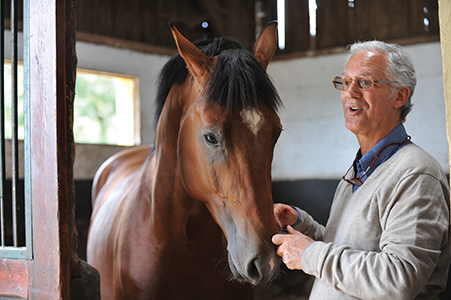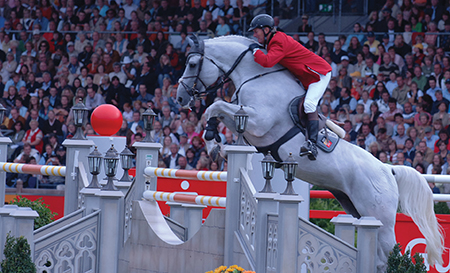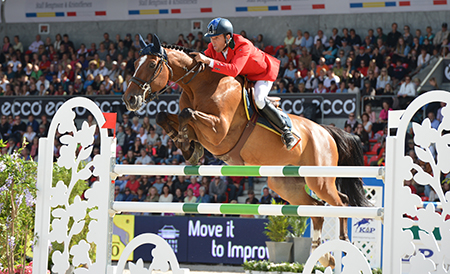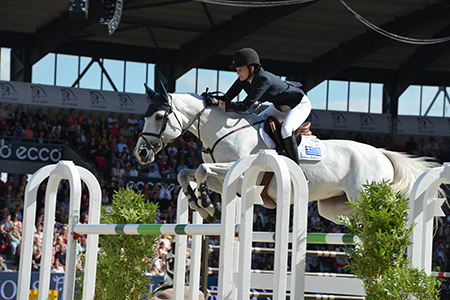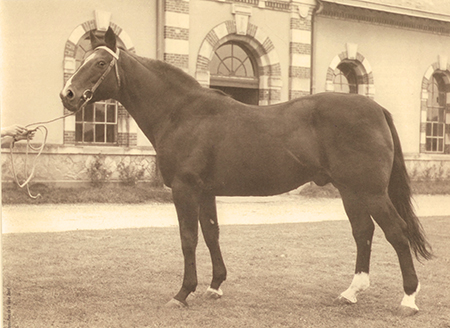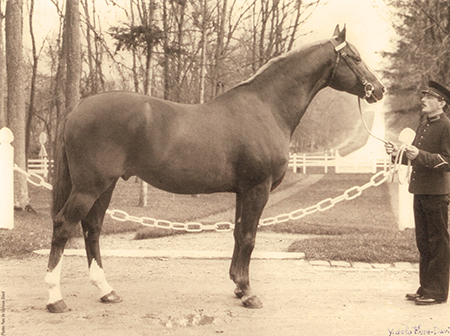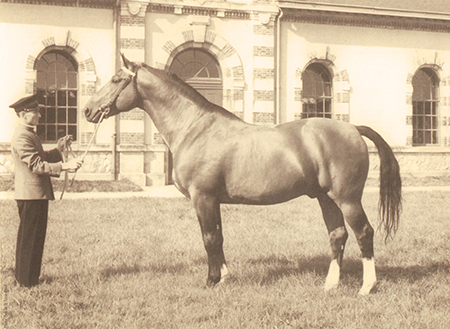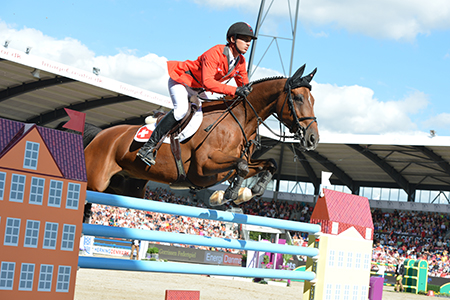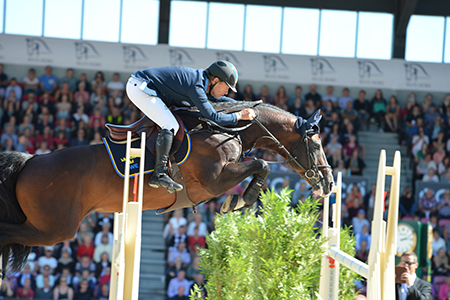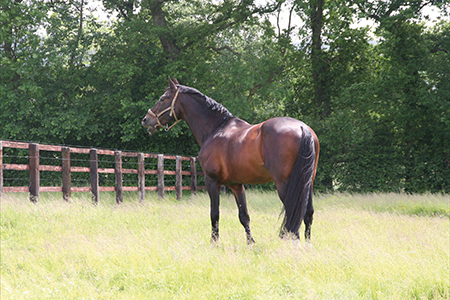In the most recent edition of the magazine, Le Selle Français (No 16, 1st trimester 2013), the current president of the Selle Français, Bernard le Courtois, contributes one of his thoughtful annual reviews of the influential stallions in the SF studbook. Bernard prefaces his rankings with these observations:
Here are the top 15 stallions who are approved by the Selle Français studbook who are the sires of the most winners in CSI classes who are amongst the top 100 of the best Selle Français jumpers in the world in 2012.
Most remarkable is the domination of the male line of Ibrahim. Almost a majority of the leading stallions are descended from Ibrahim through two branches, that of Double Espoir (Apache d’Adriers, Timorrak des Isles) and mostly that of Almé through Jalisco B, the sire of Quidam de Revel (out of a mare by Nankin), Dollar du Murier (mare by Uriel), and Scherif d’Elle (Prince du Cy) and through his other important son, Almé who is responsible for Quick Star, and Baloubet du Rouet.
The stallion line of Nankin (by Fra Diavolo xx), which was so important in the 80’s, is only represented by Rosire, and this line might vanish in the years to come.
Alligator Fontaine brings from his sire, Noren, the rare and valuable blood of Mourne xx, through his father, Sire xx. Mourne xx was also the grand-father of Laudanum xx. This Thoroughbred bloodline crosses exceptionally well with the line of Jalisco B.
Most important of the ‘foreign’ blood is that of the Holsteiner, Capitol I, through his sons Carthago and Cumano.
The blood of the Selle Français ‘export’ Furioso II (by Furioso xx) returns to France thanks to Voltaire and Kannan.
Finally we find the blood of Landgraf (Ladykiller xx) provides a beneficial touch through Lando. These three lines provide an outcross for most of our Selle Français mares.
The Selle Français horses at the highest level are principally from the seven great international jumping lines, but it is incontestable that the grand chef de race Selle Français is Almé.
These are the great treasures of French breeding. Some of them you will be very familiar with, but you will discover some surprises, stallions that you perhaps did not take notice of. This poses the interesting question, why the breeders pass to one side a stallion without using him? For certain, the roll of the dice has passed, since they are dead or retired without leaving a true legacy, while others may be still available through frozen semen.
The top fifteen stallions on the basis of the number of winners of CSI classes in 2012
- Quidam de Revel (Jalisco) 8
- Kannan (Voltaire) 8
- Diamant de Sémilly (Le Tot de Sémilly) 7
- Cumano (Cassini I) 6
- Dollar du Murier (Jalisco) 5
- Quick Star (Galoubet) 4
- Carthago (Capitol I) 3
- =8 Alligator Fontaine (Noren), Apache d’Adriers (Double Espoir), Baloubet du Rouet (Galoubet), Lando (Lancier), Rosire (Uriel), Scheriff d’Elle (Jalisco), Timorak des Isles (Double Espoir), Voltaire (Furioso II) 2
But Bernard has long been a thinker who keeps refining the figures, looking beyond the obvious and so he introduces another ranking – this time taking into account the number of foals by the stallion.
Second Classification – by the % of winners to progeny born (1999 – 2003)
- Cumano (Cassini I) 6/61 = 9.83%
- Timorak des Isles (Double Espoir) 2/42 = 4.76%
- Lando (Lancier) 2/49 = 4.08%
- Carthago (Capitol I) 3/43 = 3.97%
- Baloubet du Rouet (Galoubet) 2/91 = 2.19%
- Scheriff d’Elle (Jalisco) 2/96 = 2.08%
- Quidam de Revel (Jalisco) 8/425 = 1.88%
- Kannan (Voltaire) 8/465 = 1.72%
- Dollar du Murier (Le Tot de Sémilly) 7/440 = 1.59%
- Diamant de Sémilly (Le Tot de Sémilly) 7/440 = 1.59%
- Alligator Fontaine (Noren) 2/148 = 1.35%
- Quick Star (Galoubet) 4/397 = 1%
- Voltaire (Furioso II) 2/260 = 0.76%
- Apache d’Adriers (Double Espoir) 2/313 = 0.63%
- Rosire (Uriel) 2/515 = 0.38%
Cumano
Cumano’s foals of 2001
I was intrigued with Bernard’s second list, particularly the extraordinary result for the Holsteiner stallion Cumano, based on his one season in France.
Cumano’s crop of 2001 is truly extraordinary. On the SJA database he is listed with 60 competitors who have registered CSI placings, born between 1997 and 2005, and of these, 24 were born in 2001 and Selle Français registered.
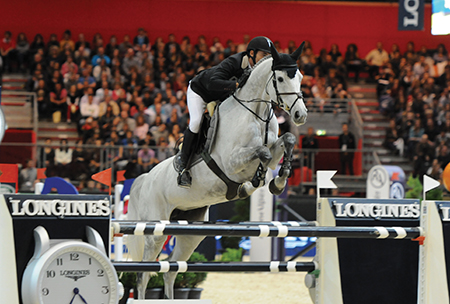 Nasa and Steve Guerdat, the mare was eight in the CSIO5* at Spruce Meadows in September
Nasa and Steve Guerdat, the mare was eight in the CSIO5* at Spruce Meadows in September
Neptune Brecourt by Cumano, qualified for WEG with rider Luca Maria Moneta (Italy)
They include Steve Guerdat’s Nasa (out of a mare by Prince d’Elle) – 2nd at Calgary in 2013; Nectar des Roches (Count Ivor xx) fourth at Vichy*** with Edouard Couperie; Nenuphar’Jac (Pidayack), a consistent GP performer with Michel Robert, and with his retirement, now back with Penelope Provost; Neptune Brecourt (Kayack), 10th at the 2013 European Championships with Lucia Maria Moneta; Newton du Haut Bois (Quat’Sous) 2nd in a 1.45 at Calgary with Cameron Handley. (Interesting: Pidayack and Quat’Sous are both by Kayack – who is by Rakosi xx out of an Ibrahim / Ultimate xx mare.)
Then we have Noblesse des Tess (Irake) who was 4th at the London Games with Kamal Bahamdan, and Notre Moinerie (Qredo de Paulstra) double clear in the 2nd placed Swiss team at Lummen Nations Cup with Carlo Pfyffer.
Camille Z and Athina Onassis, individual starter for Greece at this year’s WEG
Cumano is an example of the modern trend of a great sporting career paralleled by a great breeding career. Cumano was retired with great ceremony at Aachen in 2011.
Jos Lansink took over the exclusive ride on the stallion in 2003 and they became one of the greatest combinations, ever. The pair won the World Championship at Aachen WEG in 2006, where the massive Holsteiner gave the three lady riders in the four way jump off, sweet rides. In 2007, he was 2nd at the Europeans, and in 2008, 2nd at Calgary and 9th at the Beijing Games.
An interview with Bernard le Courtois
For a long time you were a critic of the French breeding establishment – through your campaign against the use of the BLUP, through your campaign to open the Selle Français studbook to outside influences, but here you are president of the Selle Français association…
“Not for long, I will stop being the president in May next year. I am very busy with my stud farm, I have to work, and I have spent too much time working for the Selle Français over the past two years. I have to go back to work.”
But there has been a big change – a critic in the past to become a president…
“Talking about the BLUP, we had that in the Selle Français selection only when the National Stud was the manager of the studbook. After that, when Philippe Curti was the president before 2007, we still had the BLUP in the breeding program but when Yves Chauvin, who was the president from 2007 to 2012, took over, we stopped using the BLUP in the breeding program. And this year we have asked the National Stud, to stop publishing the BLUP, because we don’t want to use it, and we don’t want it published. We asked the National Stud to give the information to the Selle Français studbook, and we can decide what to do with it. It could be interesting for the overall population of the horses but not for the horses individually. We consider the publication of individual BLUP figures is too dangerous.”
Nankin
You have long argued for the introduction of outside blood, that has certainly happened now…
“When the National Stud obliged the breeders to use the BLUP for the selection of the stallions and the broodmares, we had a problem – the studbook was closed and the new genes came only from the Anglo-Arab and the Thoroughbred stallions, and sometimes Thoroughbred mares and Trotter mares. But because of the BLUP we used only four sire lines, Ibrahim and Almé, the most popular, then the line of Nankin / Uriel, and the third was Grand Veneur, then a few from the Thoroughbred Laudanum.
Grand Veneur
Just three Selle Français sire lines, that is very dangerous. The BLUP pushed all the breeders to use the same stallions with a very high BLUP – at that time, if a colt foal was born with a BLUP of more than 20 points, the rules said that it will be approved automatically as a stallion because of the BLUP. That was really stupid – it can have very bad legs, a bad back, but if it had more than 20 points, it was approved automatically. This was very dangerous. For ten years the national stud said, we stop using the horse experts to approve the stallions and we used only the BLUP, we stopped the conformation test for ten years, and the quality of the horses conformation went down… and all the other studbooks laughed at us!”
“When Yves Chauvin arrived in 2007 as president, we decided to stop using the BLUP as the criteria for the selection of the horses. With only three sire lines, we needed new genes – the breeders were not even using the Thoroughbred blood because the BLUP for the Thoroughbred is zero, because they race they do not jump. We had no new genes to cross with the Selle Français mares, it was time to open the studbook to stallions from abroad. We had started to open the studbook just a little in the 90s.”
Ibrahim
“My opinion at the time was to have a connection with the Holsteiner Studbook because the pedigrees of the Holsteiner are very close because they used Selle Français, like Cor de la Bryère, Almé, Quidam, and they have a selection mostly for jumping horses, and I thought it made sense for us to combine with the Holsteiners. But at the time, our studbook had different ideas, and the three first stallions approved were Abdullah, Trakehner, Donnerhall, an Oldenburger for dressage, and Voltaire, a son of the Selle Français, Furioso II and no Holsteiner.”
“Then around 1995 the studbook to all the stallions approved in Europe, if it was in a studbook recognized by the WBFSH, it was automatically approved in France. And we saw many many young stallions, three years old, approved at the licensing, but without the performance test, coming to France to breed a lot. We thought that was very dangerous because it was not the job of the Selle Français to test the young stallions from abroad. We have our own stallions to test. So in 2008 we decided that the young stallions coming to France to breed had to take part in our championships – we wanted to see them jump in the Cycle Classique, and approve the stallions only after they had competed in Fontainebleau or Pompadou in the Finals. We did that for some years – with a Selle Français judge at the finals who also looked at the conformation, and the style of the jump.”
“This year we have made another change. We want to close the studbook and stop approving the 4, 5 and 6 year old stallions from abroad. In Fontainebleau and Pompadou this year, we approved only the Selle Français and some Anglo-Arab. And the championship show was only open to Selle Français and Anglo-Arabs, not the imported horses. Now we only approve foreign stallions after they are seven years old. Now the championship show is reserved for the horses from our selection program – horses from Zangersheide or Hanover, are not in our selection program, and therefore these horses do not come to our championship show, just horses from our selection program.”
“If a stallion comes from abroad, he can breed in France, because now Europe is very open, but not in the Selle Français studbook. There are two possibilities – the first is to produce foals called ‘OC’, they don’t go into the studbook, it is a register and if the stallion is approved later, we can get back the OC foals and move them into the studbook, on the basis of the stallion’s results in showjumping. The other possibility is to register in another studbook, like Zangersheide. But if they register the foals with Zangersheide, they cannot come back to our studbook. The stallion can become approved in our studbook on the basis of his jumping, and the foals registered OC can come back to the studbook on the basis of their jumping.”
How would that affect a stallion like Cumano?
“He was approved at the time, when he was in France twelve years ago for one season. That season he bred about 60 mares for about 40 foals with amazing results, I think 25 jumped Grand Prix – amazing. The problem of Cumano was that he was a huge stallion, and the two French riders who rode him as a seven year old, had not good results in competition. They didn’t like the stallion because he was too heavy for the French riders, especially these two riders who ride more with instinct than with work and dressage. Then when the stallion moved back to Belgium with Jos Lansink, he had fantastic results because Jos Lansink is a rider who will ‘dress’ a horse, and work strongly with the stallion – and I think Cumano needs that because he is so huge. He was not the type of horse for the French riders, but he crossed very well with the French mares.”
“I think he was a very good stallion because if you look at the pedigrees of the French mares who bred these Grand Prix horses of Cumano, usually these mares were not exceptional, he didn’t breed to the best mares in France. He bred correct mares but not the best ones, and he had very good results. His problem now is his fertility, the fertility is very bad…”
Was he the best foreign stallion to come into the Selle Français studbook?
“The stallion who has the best result at the moment is Kannan, he is second in the world rankings as a sire. In the opinion of the Selle Français studbook, we have a problem, we have a few stallions who breed to too many mares. Kannan covers around 600 mares a year in France, and maybe the same abroad – more than 1000 mares a year world wide, it’s incredible, but really too much. He is a good stallion, he produces easy horses to ride, good competitors, most of them in two star, three star international shows, some of them in five star, like Nino de Buissonnets, it’s a really good stallion.”
Nino des Buissonnets and Steve Guerdat
“We have some problems with other stallions, not so successful with bad temperaments, and because of the promotion of these stallions, they are breeding more than 400, 500 mares a year, and the studbook would like to stop that. We consider these stallions could be interesting but not breeding so many mares, that is dangerous, some of them have bad temperament, bad technique, not very good conformation, but the promotion is so good that the breeders use these stallions.”
“The board of the studbook considered the question of making a quota of 200 mares, like we did in the past, because we consider these stallions – who are not at the moment the best in the world – are too dangerous to use in these numbers. But we have a problem, if we say, next year we will have a quota of 200 mares. The stallion owners say, okay for the Selle Français quota of 200 mares, the price will be double, or three times more expensive.”
“But if they have a higher price for the Selle Français mares, then the price were the mares outside the quota will be much lower, and with the mentality of the new breeders, maybe they don’t care to have a Selle Français. They would prefer to pay a cheaper fee and register the foal outside the studbook – we would be giving to other studbooks like AEA, or Oldenburg or Zangersheide, maybe 2000 foals every year. Every breeding association in the world has problems at the moment with the number of mares being bred, and it is not possible to give a big present like that to the other breed associations.”
Casall Ask, the best stallion in Holstein at the moment
“So we decided not to have a quota, but we try to explain to the breeders that it is stupid to use stallions that are not really proven, just well promoted, but we have no authority. For example, two weeks ago, at the Selle Français show, we had the staff of the Holstein Verband there, and over lunch we were talking about the policies with the stallions and the breeders. I put the question, what do you do with Casall, the best stallion in Holstein at the moment, and they said, we have a quota of 350 mares for Casall, but he is owned by the Holsteiner Verband and they can decide what they want to do. But if the best stallion in Holstein is a private stallion, then it is impossible for them to do anything, if the stallion owner sells 600 services a year, they have no power. In France, the Selle Français studbook is not the owner of any stallion. We can’t decide for the breeder, if 500 breeders want to use the same stallion, we can’t do anything.”
You can’t remove the approval from the stallion to breed on the basis of the progeny?
“When you have a stallion that breeds, 200, 300, 400 mares every year, you have automatically several good horses because they breed to some very good mares, and the people say, look at my stallion, he has good results, he has four or five horses in the world ranking – yes, but he bred so many mares that this is normal, he should have not five, but 50 or 100. We have the same situation at the championships in Fontainebleau, everyone says, the best stallion in France is Kannan, or Conturo, but they breed so many mares, there are so many of their progeny on the jumping circuit, so it is no surprise that so many qualify for the championships.”
“The other problem with the few stallions breeding so many mares is this: at the moment we have around 8000 mares breeding, if you have 2000 bred to two or three stallions, that is 20-25%. During this time, the breeders never test the young stallions, and never use the stallions who breed only 20 to 40 mares. Some of them are of equal quality to the stallions who are breeding 500 mares. It is only that some stallions are more fashionable, but they are not better than the other ones. Our problem is particularly that, we would like to test more stallions, because the danger is that we can lose some good stallions that are never given the chance to prove just how good they are. It is very important to test the young stallions, because that is the future – the good stallions will be the young ones that we are selecting now. That is the problem of the Selle Français at the moment.”
In France is it the same as Germany and Holland, less mares bred, the horse industry is not going well?
“I think from 2008 everywhere in Europe the breeding is down. The timing of the decline is different in every country. I don’t know why. The first country to experience this loss of breeding mares, was Sweden in 2008 – Flyinge Stud closed in 2009 because they lost 50% of the stud fees in one year and they sold all the stallions. In Ireland, in Germany, in Belgium, the number of mares bred are down. In France, from 2008, we lost around 5% every year, in five years that is 25%, but the worst was in 2013, when we lost 20% of the stud fees. I think it is more because of the new government, the new taxes, and the French people decided not to breed this year. I hope next year they will start to breed again.”
“Some people say it is a good thing, that in the past in Europe, too many horses were born, and the loss of 50% of the mares, means that the market will go up in a few years when demand exceeds supply. I don’t know, at home on my farm, I continue to breed 30 mares, hoping that the market will be better in a couple of years.”
Kannan (photo Groupe France Elevage)
“It is a new private market now. The National Studs will stop being stallion owners next year, and we will have only private stallions. People can buy a stallion anywhere and import it. If they want the stallion approved by the Selle Français studbook, they have to show him to the committee, and the decision will be determined by his own performance and the performance of the progeny in international classes, and if the horse has good enough results, then we approve the stallion.
What new young stallions are looking good in France?
“Mine, first. (Bernard is chuckling) It is very difficult because there are only very few young stallions who breed enough mares to see the foals in the foal show. For example, at the Selle Français show we saw some foals by new young stallions but very few. When you have a stallion that breeds 500 mares a year, then at the foal show, you see only the foals of this stallion. You can’t see the other ones. Sometimes the winner of the stallion show can breed 50 or 100 mares but only one season, and if the stallion doesn’t have a good result at four and five years old, then the breeders stop using him and start again when the stallion jumps very well at seven or eight – or when the first four and five year old progeny arrive on the market and jump very well.”
“The mentality of the Selle Français breedeers is not the same as the mentality in the Netherlands or Germany. For example, if you go to Elmshorn, or s’Hertogenbosch for the licensings, you can see 5000 people watching the young stallions. In France it is impossible. You have 300 people to see the stallion show. The breeders are not interested in the new stallions, they prefer to use the stallions that they can see on the TV on Sunday night, not the young ones.”
“Sometimes in France when you have a very good young stallion you have to give the service to the breeder for free. The policy of the breeders like Haras Couvains, or Mr Valois, or myself, is that we say okay I have a new stallion, he has a fantastic pedigree, top conformation, he jumped very well at the stallion show, and he is approved by the Selle Français studbook, and if you buy a stud fee of one of the older stallions, then you can have a free breeding to the younger one. That is the only way to test the young ones.”
“The breeders never thinks about what we have to invest to produce a new stallion: genetically, to keep the mares, to buy the semen, to select the foal, to prepare the young horse for the stallion show, it costs a lot. Then we have to train the stallion, to jump him at four and five, and yet, to get some mares for him, you have to give him away free. That is incredible…”

